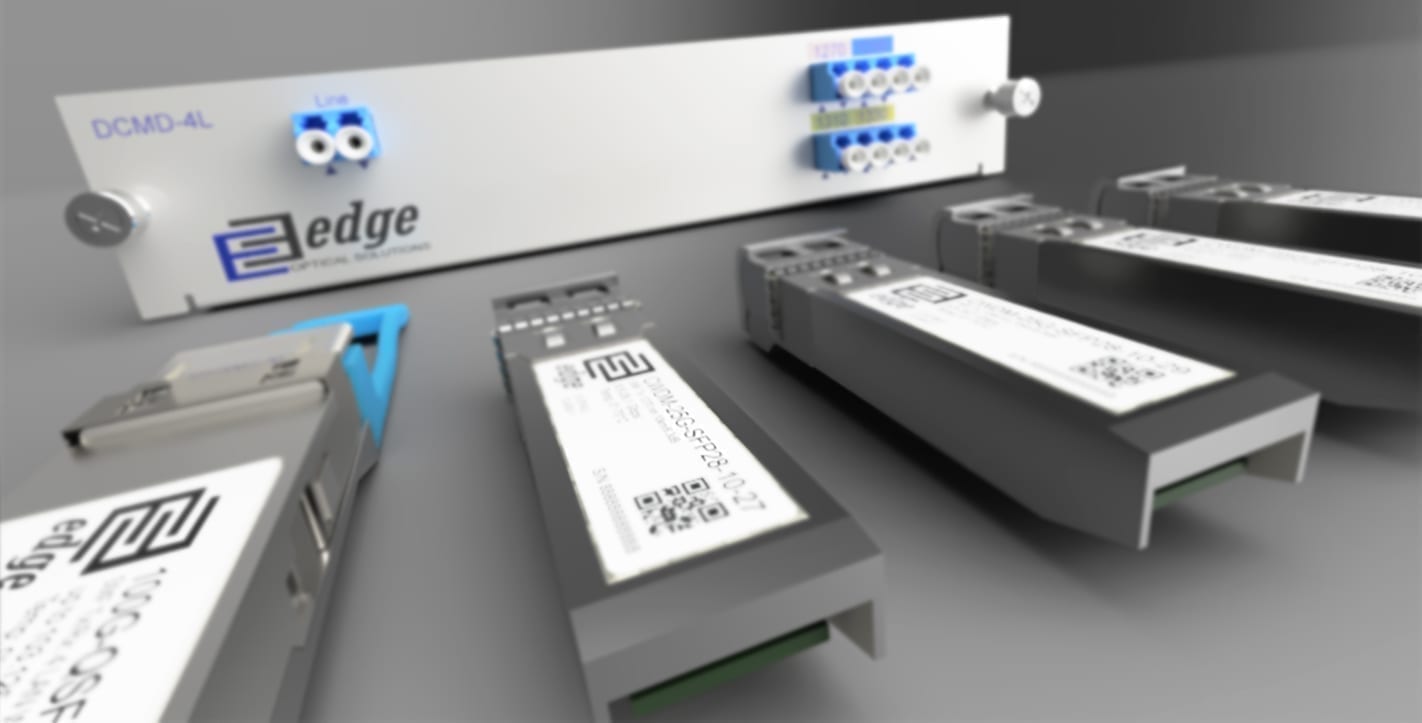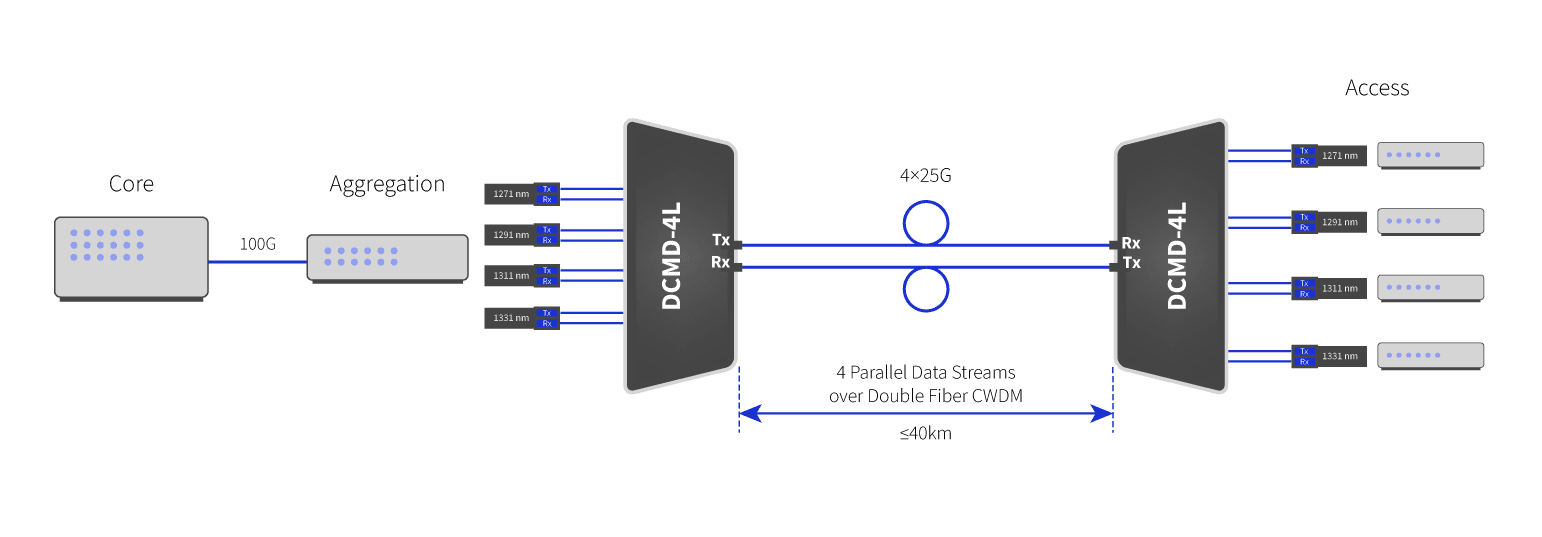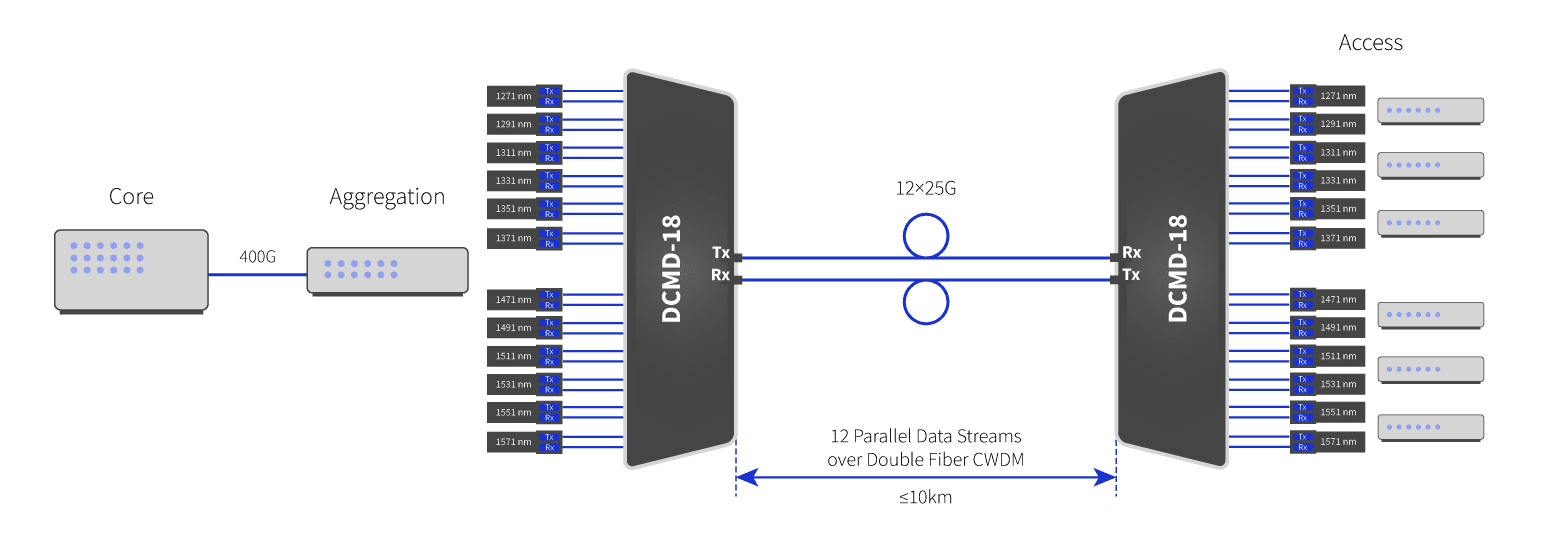
25G SFP28 CWDM – Passive CWDM 3rd generation
25G SFP28 CWDM article focuses on Passive CWDM (Coarse Wavelength Division Multiplexing) 3rd generation which is one of xWDM technologies. Advancing from 10G Ethernet per channel to 25G Ethernet per channel. A short recap – CWDM multiplexes a number of optical carrier signals onto a single optical fiber, using different laser light wavelengths and is defined by ITU-T G.694.2 specification. Resulting in greater data throughput. Additionally, each wavelength has a predefined latch color for easier identification.
- 25G CWDM vs DWDM vs LWDM
- 25G CWDM Available Wavelength
- 25G Supported Data Rates
- 25G SFP28 CWDM Common Ethernet Network Scenarios:
- 25G CWDM Transceiver Compatibility
- Conclusion
This article will have more information on the 25G Ethernet side use case and less on the 5G Mobile Fronthaul or 32G Fiber Channel side, which is covered in 25G SFP28 transceivers: Quo Vadis?
Nowadays, Passive CWDM technology has been widely adopted and is among one of the most efficient ways to interconnect Fixed Mobile Operator Metro Networks, have redundancy between Data Centers and connect Enterprise Core with Branch Offices.
Time ago passive CWDM networks have been mostly using 10G and sometimes 1G per channel data rate. A viable, cost efficient and industry widely adopted technology to support higher data rates did not exist outside laboratories. 25G, 40G or 100G Single Channel CWDM technology and technical capability was not available. With IEEE 802.3cc 25G Ethernet standardization and 25G laser advancement, doors for a world wide 25G rollout have opened.
25G CWDM vs DWDM vs LWDM

To better understand 25G SFP28 CWDM, let’s zoom out a bit, check the surroundings by comparing 25G SFP28 CWDM with other xWDM alternatives – 25G DWDM SFP28 and 25G LWDM SFP28.
Firstly, let’s compare 25G SFP28 CWDM vs 25G SFP28 DWDM. 25G DWDM is capable of providing much more channels, 45 to be precise, all according to DWDM ITU 100Ghz Grid. However, at this point in time 25G DWDM SFP28 lasers with 40 km distance are under development. This leaves us with using 25G DWDM SFP28 single channel capable systems that work at a maximum length of up to 10 km. However, DWDM systems, as usual, utilize signal boosters, to boost 1550nm wavelengths, and dispersion compensators, to aim for longer distance.
For now, the total solution cost of 25G DWDM SFP28 is much higher than 25G SFP28 CWDM. That is why, when it is required to interconnect twelve (12) or less 25G channels between sites and the distance is below 40 km, 25G SFP28 CWDM is the way to go.
Secondly, let’s compare 25G SFP28 CWDM vs 25G SFP28 LWDM (LAN WDM). 25G LWDM SFP28 is currently limited to 12 channels that range from 1269.23nm to 1318.35nm. This is the same amount of channels that are available in 25G SFP28 CWDM. Optical components for 25G SFP28 LWDM are relatively new and are more expensive than the ones for 25G SFP28 CWDM. However, the main advantages for 25G SFP28 LWDM is the support for 40 km range and Industrial Temperature (from -40°C to +85°C). 25G SFP28 LWDM 40 km lasers are becoming more widely available in the market which is great news for the end user. Because the competition between 25G SFP28 CWDM and 25G SFP28 LWDM will make both type transceivers more affordable.
Additionally, an important aspect to mention about 25G SFP28 LWDM is that 25G SFP28 LWDM use same channels as in 100G QSFP28 LR4 and 100G QSFP28 ER4 (1295.56, 1300.05, 1304.58, 1309.14 nm) and, even better, 400G LR8 (1273.55, 1277.89, 1282.26, 1286.66, 1295.56, 1300.05, 1304.58, 1309.14 nm). This means that 25G SFP28 LWDM modules can be connected to 100G QSFP28 LWDM4 and 400G QSFP-DD LR8 modules. This is an additional reason why 25G SFP28 LWDM is a good potential alternative to 25G SFP28 CWDM when looking to the future.
CWDM Available Wavelength
 25G SFP28 CWDM, as previously mentioned, has a smaller available wavelength range when compared with 1G CWDM SFP and 10G CWDM SFP+. In 1G CWDM SFP and 10G CWDM SFP+ solutions we have the ability to use full ITU-T G.694.2 CWDM Channel plan that is from 1270nm to 1610nm, with a 20 nm step between each channel. Thus, 1G SFP CWDM and 10G SFP+ CWDM can utilize 18 Channels, over double fiber, or 9 Channels, over single fiber.
25G SFP28 CWDM, as previously mentioned, has a smaller available wavelength range when compared with 1G CWDM SFP and 10G CWDM SFP+. In 1G CWDM SFP and 10G CWDM SFP+ solutions we have the ability to use full ITU-T G.694.2 CWDM Channel plan that is from 1270nm to 1610nm, with a 20 nm step between each channel. Thus, 1G SFP CWDM and 10G SFP+ CWDM can utilize 18 Channels, over double fiber, or 9 Channels, over single fiber.
25G SFP28 CWDM LR have available 12 from 18 ITU-T defined channels. For lower wavelengths, that are in range from 1270 nm to 1370 nm, transceivers use a very cost efficient DML Laser and PIN Receiver solution. For higher wavelengths, that are in range from 1470 nm to 1570 nm, transceivers use a more expensive EML laser and APD Receiver solution.
Middle wavelengths, that are in range from 1390nm to 1450nm and end wavelength 1590nm and 1610m, currently are not usable for 25G SFP28 CWDM due to high dispersion.
25G SFP28 CWDM ER modules will be available in the same ranges as LR transceivers, but at this time available are the lower wavelengths of 1270nm-1370nm, DML Laser and PIN Receiver solution. Higher wavelengths of 1470nm-1570nm, EML laser and APD Receiver solution, has not yet entered into mass production stage.
25G Supported Data Rates
25G SFP28 CWDM has an important aspect that requires attention. It is that 25G data rate is the maximum data rate which can be achieved on 1 lane with NRZ modulation using 0’s and 1’s (light is on and light is off, respectively) due to Nyquist frequency and rate. All of the higher single lane data rates 100G-200G-400G-800G are achieved either by adding more parallel transmission lanes or by changing modulation to, for example, PAM4 (Pulse Amplitude Modulation 4-Level) or by doing both at the same time. More on this can be read in 100G Single Lambda (100G PAM & Single Lambda) article.
25G SFP28 CWDM module supported data rate – data rate at which modules will operate – depend on 2 main factors, same as for other optical transceiver:
- What data rate is supported by a hardware chipset?
- What data rate has been programmed in module EEPROM memory?
25G data rate hardware chipset options:
25G SFP28 CWDM hardware chipsets have two main types.
- Chipset supports 24.33 – 25.78 Gbps data rate and following applications: 25G Ethernet (25.78Gbps) and CPRI option 10 (24.33 Gbps);
- Chipset supports 8.5 – 28.1 Gbps data rate and following applications: 25G Ethernet (25.78Gbps), 10G Ethernet (10.31Gbps) and CPRI option 10 (24.33 Gbps), CPRI option 9 (12.165 Gbps), CPRI option 8 (10.138 Gbps), CPRI option 7 (9.830 Gbps).
25G data rate EEPROM memory options:
Data rate is set and configured in EEPROM memory. This technically allows the transceiver to be programmer so it would support all the applications or one specific data rate which is supported by the chipset.
However, to correctly prepare 25G SFP28 CWDM, it is important to know in what platform, equipment or application the transceiver module will be used. This is because some compatibilities require a specific EEPROM data rate which is programmed based on the platform in which the module will be used. Nevertheless, in some cases EEPROM can be set to limit 25G SFP28 module to, for example, a 10G Ethernet data rate.
25G SFP28 CWDM Common Ethernet Network Scenarios:
Below we will take a look at 3 common network scenarios for 25G SFP28 CWDM solution deployment.
Scenario 1 – 100G CWDM4 to 4x25G SFP28 CWDM up to 10 km
This is a very efficient 100G to 4x25G tree topology network design, where 100G can be deployed in the Aggregation sites and 25G could be deployed in the Access sites.
To establish a link, it is required to use a 100G QSFP28 CWDM4 10 km module (100G-QSFP28-11), which are designed according to 4WDM MSA standard use 4 CWDM wavelengths: 1271nm, 1291nm, 1311nm and 1331nm wavelength. This matches wavelengths that are used by 25G SFP28 CWDM. Connection is visible in the image above and can be achieved via a MUX/DEMUX unit.
Additionally, 100G QSFP28 CWDM4 technology is gaining momentum due to the component maturity and cost decrease in production. However, the reach for extended CWDM4 is not likely to increase from the 10 km available now.
To achieve this connection, we recommend using two OS2 fibers and:
- At one end, a 100G QSFP28 CWDM4 (100G-QSFP28-11)
- At another end, a 4 Channels Double Fiber Low-band Passive CWDM Mux/Demux (DCMD-4L) and 4x 25G SFP28 CWDM modules, CWDM-25G-SFP28-10-27, CWDM-25G-SFP28-10-29, CWDM-25G-SFP28-10-31 and CWDM-25G-SFP28-10-33).
Scenario 2 –4x25G CWDM to 4x25G CWDM up to 40 km
25G SFP28 CWDM has another low cost and efficient scenario where four 25G SFP28 CWDM channels are interconnected between 2 sites over double fiber. Distance can be up to 40 km. This is similar to the widely used 10G SFP+ CWDM system and can use the same fiber.
The building blocks are the same as in Scenario 1. Requiring two 4 Channels Double Fiber Low-band Passive CWDM Mux/Demux DCMD-4L, together with CWDM-25G-SFP28-10-27, CWDM-25G-SFP28-10-29, CWDM-25G-SFP28-10-31 and CWDM-25G-SFP28-10-33 optical modules for each side.
Scenario 3 – 12x25G CWDM Channels
Even higher efficiency 25G SFP28 CWDM solution scenario is to go with a double fiber and go for the maximum number of channels possible. That is to use all 12 available 25G SFP28 CWDM channels.
We recommend using two 18 Channels Double Fiber Passive CWDM Mux/Demux (DCMD-18) together with CWDM-25G-SFP28-10-XX modules in lower wavelengths range of 1270nm-1370nm and higher wavelengths range of 1470nm-1570nm wavelengths.
25G SFP28 CWDM Transceiver Compatibility
25G SFP28 CWDM and 25G Grey modules have matured and we have gathered enough technical know-how on almost all well-known brands such as Cisco, Mellanox, Intel, Huawei, Dell, Lenovo, Brocade, Arista, Extreme Networks and others.
However, with the 25G SPF28 CWDM Optical modules, there can be a lot of situations when vendor original platforms do not support 25G CWDM modules and we would have to use Hybrid Transceiver Coding approach to achieve the desired compatibility.
Conclusion
25G SFP28 CWDM is coming and it will re-shape the potential of 10G SFP+ CWDM infrastructure to increase throughput by up to 2.5 times. It is good to keep in mind, while constructing 25G SFP28 CWDM solutions, that as of this writing it can reach up to 40 km range and we have ability to implement them in combination with 100G QSFP28 CWDM4 Optical modules, which gives us extra flexibility when designing new network segments.
In respect to the previous generation, 10G CWDM SFP+ is here to stay for some time as its role, especially in long distance connections (80-100 km) is crucial, until the moment when 25G ZR SFP28 CWDM capable lasers will be released.
Hey – thank you for reading till the end or reading from the end 🙂 – If any questions or comments Contact Us!




